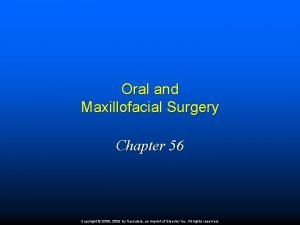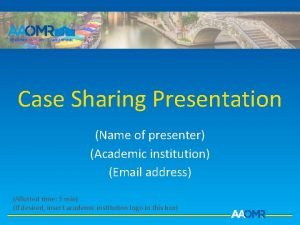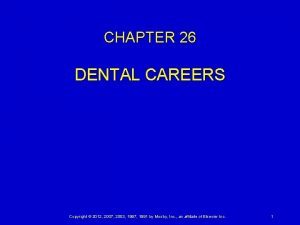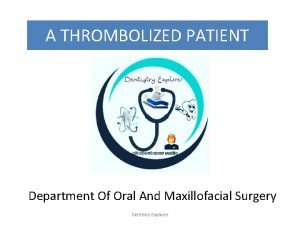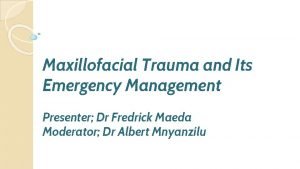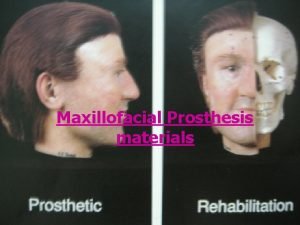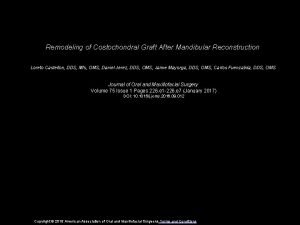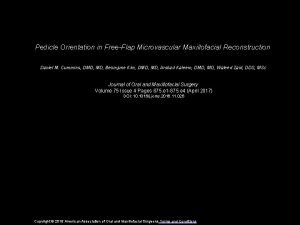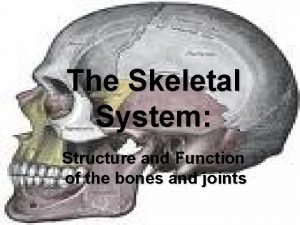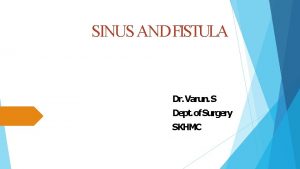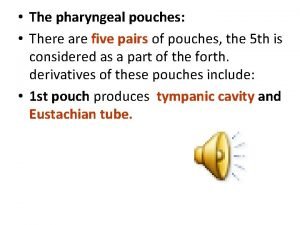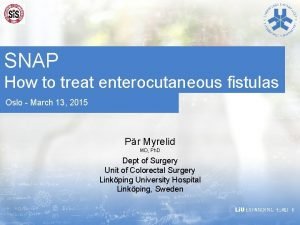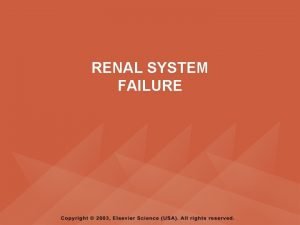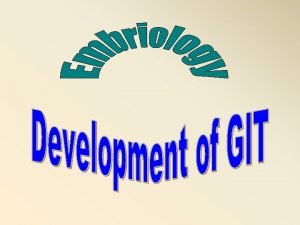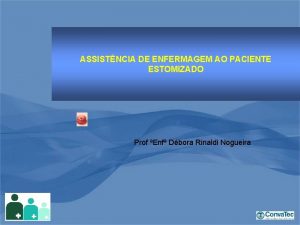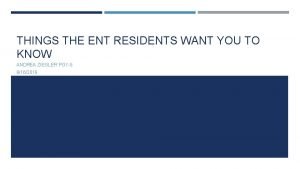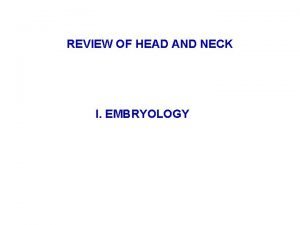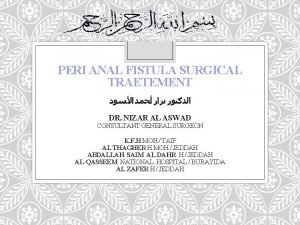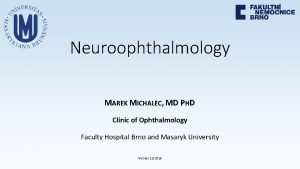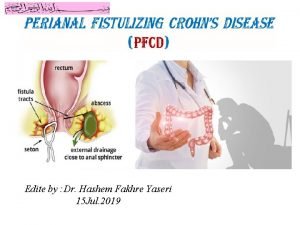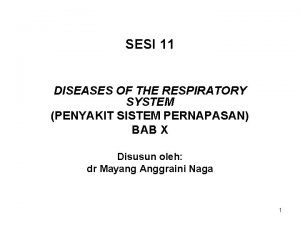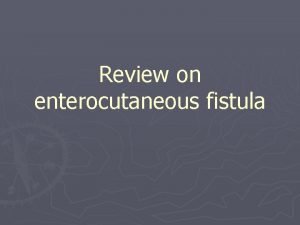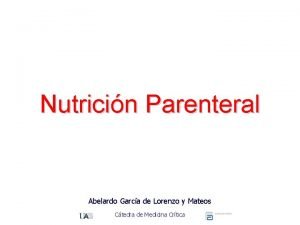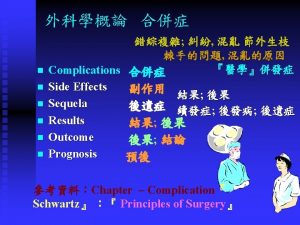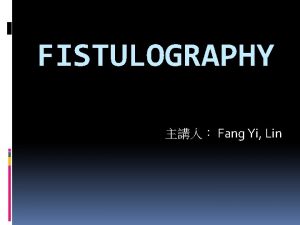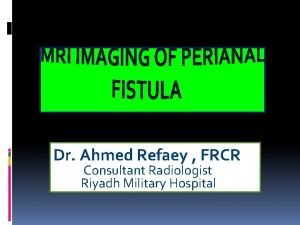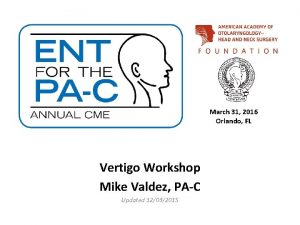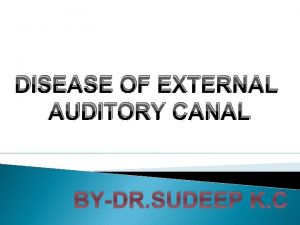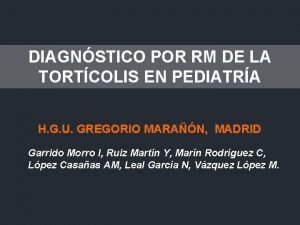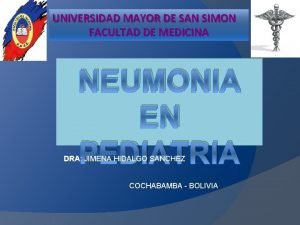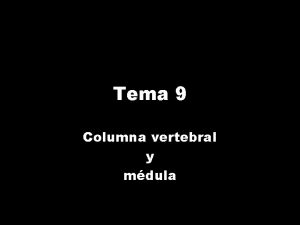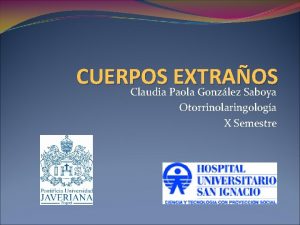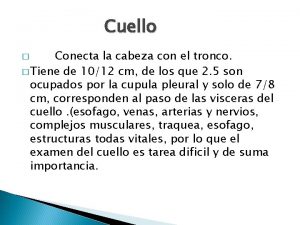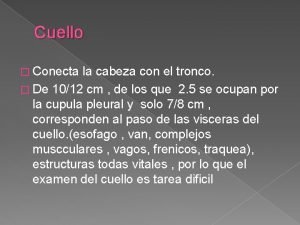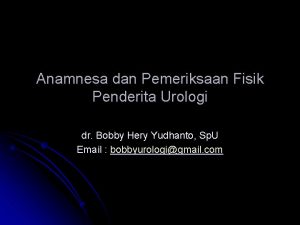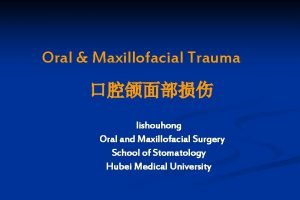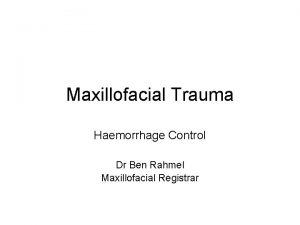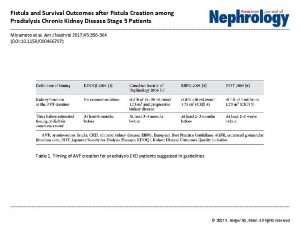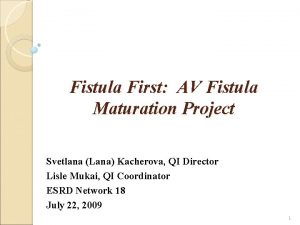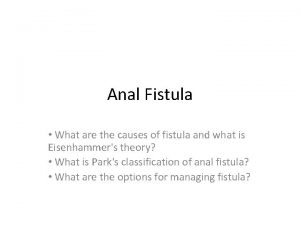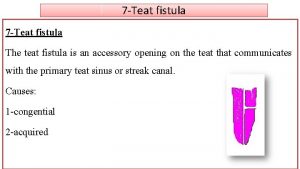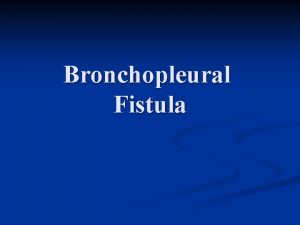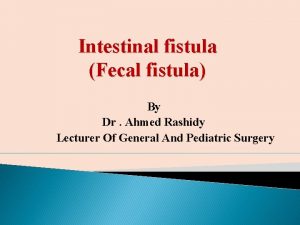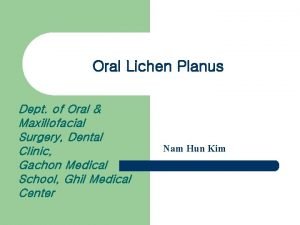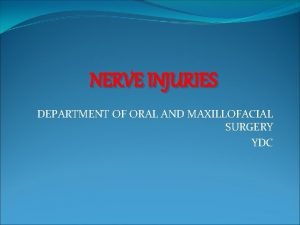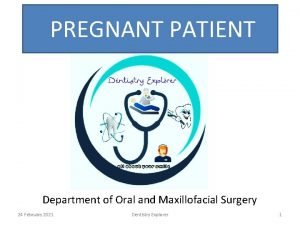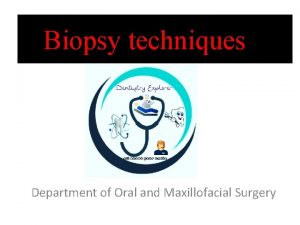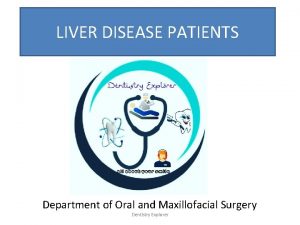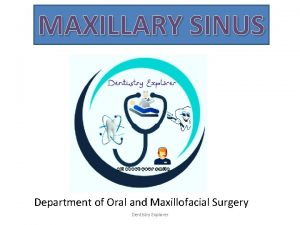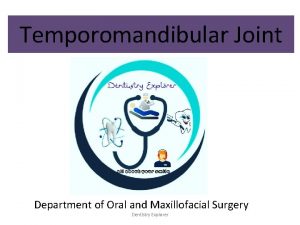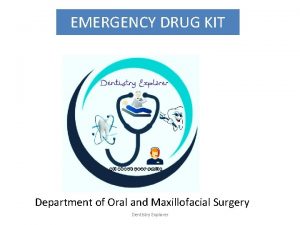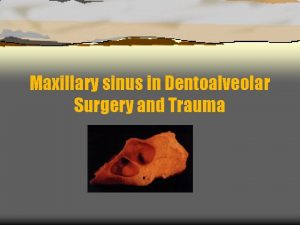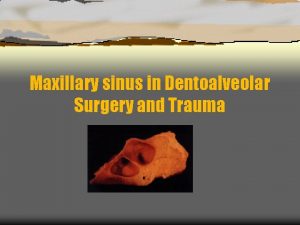Oroantral Communication Fistula Department of Oral and Maxillofacial













































- Slides: 45

Oro-antral Communication & Fistula Department of Oral and Maxillofacial Surgery Dentistry Explorer

Introduction to maxillary sinus v. Developmental aspect v. Anatomy of maxillary sinus v. Functions of Maxillary Sinus v. Examination Of Maxillary Sinus v. Oro-antral communication and Fistula v. Etiology v. Symptoms v. Diagnosis v. Treatment v. Conclusion Dentistry Explorer

Introduction to Maxillary Sinus • • • 1 st described in 1651 by Nathaniel Higher. Also known as antrum of Highmore Two in number on either side of the maxilla Largest of paranasal sinus Connects to other sinuses through lateral wall of nose Volume: -15 -30 ml 1 St paranasal sinus to develop Opens into middle meatus Pyramidal in shape Dentistry Explorer

Developmental Aspect v Appears within the 3 rd fetal month as invagination of nasal sac which slowly expand within the maxillary bones. v Rudimentary or small measuring about 2 -4 mm in diameter during birth and expand throughout the childhood v Grows by process of pneumatization v Size: -Anteroposterior-35 mm Height-32 mm Width-25 mm Dentistry Explorer

Time 3/12 IU Birth Growth Shape Outpouching in middle meatus — Tubular: 2 cm × 1 cm 3 mm per year × 2 mm Tubular 9 years 60% of adult size Ovoid 12 years Antral floor parallels nasal floor — 18 years Adult size Pyramidal Dentistry Explorer

Anatomy of Maxillary Sinus Boundaries BASE-lateral wall of the nose APEX- zygomatic process of maxilla ROOF-orbital plate of maxilla FLOOR-alveolar process of maxilla POSTERIORLY- infratemporal surface of maxilla ANTEROLATERALLY-facial surface of the maxilla Dentistry Explorer

Vascular Supply & Lymphatic Drainage v. ARTERIAL SUPPLYfacial, infraorbital & greater palatine artery. v VENOUS DRAINAGEfacial vein & the pterygoid plexus. v. NERVE SUPPLYInfraorbital, middle & superior alveolar nerves. v. LYMPHATIC DRAINAGESubmandibular node Dentistry Explorer

Function of Maxillary Sinus • Brings the inspired air into the body temperature before entering into the respiratory tract. • Helps to filter the debris from the inspired air. • Helps to enhance the resonance of voice. • Creates “air padding” and provides good thermal insulation to important nervous tissues like forebrain, olfactory region etc. • Pneumatisation makes the skull bone and facial skeletal lighter. • Sinus increases the surface area of the skull Dentistry Explorer

Examination Of Maxillary Sinus Clinical Examination • Extraoral Examination: -pain & tenderness, swelling over the prominance of cheek bones • Intraoral Examination: -pain & tenderness, swelling over the maxilla between the canine fossa & the zygomatic buttress • Transillumination: -affected sinus shows decreased transmission of light due to accumulation of fluid, debris. Dentistry Explorer

Radiological Examination • Readily available exposure area) periapical views b) occlusal views c) panoramic views • Additional information. Waters radiograph. CT Scan MRI Dentistry Explorer

Oro-antral communication and Fistula Oro-antral communication -Pathological communication between oral cavity and maxillay sinus -Fresh communication not lined by epithelium Oro-antral Fistula -A pathological epithelized canal between oral cavity and the maxillary sinus -Develops after 48 -72 hrs after OAC -Established OAF/Chronic OAF: -7 -8 days Dentistry Explorer

Dentistry Explorer

Dentistry Explorer

Etiology • Extraction of long rooted teeth • Destruction of a portion of the sinus floor by periapical lesions • Perforation of floor & sinus membrane with injudicious use of instruments • Forcing of a root or tooth into the sinus during attempted removal • Removal of large cystic lesions that encroach on the sinus membrane • Chronic infection such as osteomyelitis • Extensive trauma to face Dentistry Explorer

Symptoms Fresh Oro-antral communication -Escape of fluids -Epistaxis(Unilateral) -Escape of air -Enchanced column of air -Excruciating pain Dentistry Explorer

Symptoms of Oro-antral fistula -Pain -Persistent, purulent or mucopurolent, foul, unilateral nasal discharge -Postnasal drip -Possible sequelae of general toxemic condition -Popping out of an antral polyp Dentistry Explorer

Diagnosis Dentistry Explorer

Treatment Immediate Treatment If small( ≤ 2 mm ) in diametera) Ensure formation of high quality clot, b) Advise for sinus precaution. If moderate(2 -6 mm) in diametera) Figure of eight suture over tooth socket, b) Advise for sinus precaution, c) Antibiotics If large( ≥ 7 mm) in diameter)a) flap procedure Dentistry Explorer

Treatment of established OAF v. Surgical Closure -Flap procedure Local Flap Buccal Flaps Palatal Flaps Combined Flaps -Distant Flaps -Grafts Bone All plastic materials Dentistry Explorer

Buccal mucoperiosteal Flap Types • Advancement flap • Sliding flap Dentistry Explorer

Buccal Flap Advancement Operation • Von Rehrmann in 1936. • Most satisfactory method. Procedure • Injection of LA in the mucobuccal fold • Excision of the fistulous tract. • Elevation of the buccal mucoperiosteal flap, with flap released to depth of labial vestibule. • Buccal mucoperiosteal flap is advanced over alveolar process & sutured to palatal mucosa to close fistulous tract. Dentistry Explorer

Buccal Flap Advancement Dentistry Explorer

Rehrmann’s Buccal Advancement Flap Dentistry Explorer

Moezier Buccal Sliding Flap Dentistry Explorer

Palatal Flaps A. B. Straight advancement Veau/rotational advancement flap Dentistry Explorer

Rotational Advancement Flap Dentistry Explorer

Straight Advancement Flap Rotational Advancement Flap • Doesn’t offer much greater • Does offer much greater mobility. • Suitable for closure of minor palatal / alveolar larger alveolar / palatal defect • Mobilization of small • Mobilization of large amount of palatal tissue so amount of palatal tissue no kinking present. so often kinks following the flap rotation Dentistry Explorer

Buccal Flap Vs Palatal Flap Buccal Flaps • Are thin so more liable to tear. • More elastic • Believed to decrease the buccal vestibular height. • Less vascularised. • Simple & widely accepted technique Palatal Flaps • Thicker • It is less elastic as compared to buccal flaps • Does not affect the vestibular height. • More vascularised. • Used when buccal flap is not possible. Dentistry Explorer

Combined Local Flap Dentistry Explorer

Distant Flap Procedures v INDICATION Close larger fistulas which are technically difficult to close by the local flaps v ADVANTAGES Sufficient tissue bulk Extremely pliable Primary closure of the donor site v DISADVANTAGES Poor esthetic effect Dentistry Explorer

Types of Distant Tongue Flaps Anteriorly based partial thickness dorsal tongue flap Posteriorly based full thickness lateral tongue flap Dentistry Explorer

Dentistry Explorer

• ANT. PLACED PARTIAL THICKNESS DORSAL TONGUE FLAP • Base of this flap is situated in the mobile 2/3 rd of the anterior tongue. • Requires restrictive tethering of the mobile tongue during healing. • Mouth function & appearance is compromised • POST. BASED FULL THICKNESS LATERAL TONGUE FLAP • Base of this flap is situated in less mobile 1/3 rd of the posterior tongue. • Doesnot require restrictive tethering of the mobile tongue during healing. • Mouth function & appearance is much improved Dentistry Explorer

Graft Procedure TYPES BONES • ALLOPLASTIC MATERIALS • Dentistry Explorer

Bone Graft INDICATED -Size of defect is too large, -Recontouring of the alveolar ridge is required ADVANTAGES -Ensures strength to the flap, -Replaces the defect with similar tissue DISADVANTAGES-Requires another surgical procedures, thus increasing length of procedure & morbidity -Buccal vestibular height reduced. Dentistry Explorer

Alloplastic Materials Flap MATERIALS USED gold foil, Gold plate, Tantalum plate, soft methylmethacrylate, lyophilized collagen ADVANTAGES Simple procedure, Doesnot affect the buccal vestibular height, No raw area left behind for granulation following closure. DISADVANTAGES Expensive Dentistry Explorer

Treatment of long Standing Fistula v. CALDWELL-LUC PROCEDUR Involves creation of an opening into the nose at the level of the sinus floor beneath the inferior turbinate to allow drainage of secretion. Dentistry Explorer

Technique Ø Anesthesia Ø Incision Ø Anesthesialocal/general anesthesia, Intranasal application of xylocaine jelly, blocking of infraorbital and anterior ethmoid nerve. Submucous infiltration of the canine fossa (as a supplementary anesthesia) Dentistry Explorer

• Incision • Made at the canine mucobuccal fold. • Mucoperiostal flap is gently raised upwards to the point of emergence of the infraorbital nerve. • Window is created with chisel/burs. • Roungers forceps used for enlarging the opening. • Sinus is exposed & the secretion is cleaned out with the suction. • The antrum is packed with ribbon gauze impregmented with liquid paraffin/furacin. • Wound closed with the interrupted sutures. Dentistry Explorer

Post Operative Care Ice pack over the cheek in the first 24 hours prevent edema, haematoma & discomfort to the patient. Packing in the sinus can be removed in 24 -48 hours. Antibiotics are given for 5 -7 days. Patient should avoid blowing his nose for 2 weeks to avoid surgical emphysema. Dentistry Explorer

Complications of caldwell luc ü Post operative bleeding, can be controlled by the nasal pack ü Anesthesia of the cheek due to stretching of infraorbital nerve, ü Anesthesia of teeth, ü Injury to the nasolacrimal duct ü Sublabial fistula ü Osteomyelitis of maxilla. Dentistry Explorer

Other Procedures Buccal Fat Pad Flap -Given by Egyedi and Hao -Rapid epithelization of uncovered fat is a peculier feature of BFP flap stalk -incision is made in posterior mucosa in the area of zygomatic buttress followed by a priosteal incision and fascia developing the buccal pad of fat is excised and placed in the communication side and sutured. Advantage-good epithelization Disadvantage-decrease in vestibular height Dentistry Explorer

Sandwich Technique -Developed by Ogansalu -Bone graft material is sandwiched between the two sheats of bio-resorbable membrane -Excellent bone regeneration is obsorved Dentistry Explorer

References • Contemporary Oral and Maxillofacial Surgery-6 th edition • Peterson’s Principle of Oral And Maxillofacial Surgery -2 nd Edition • Surgical Approaches to facial Skeleton-3 rd edition • Textbook of oral and maxillofacial surgery by Neelima Anil Malik • Google. com Dentistry Explorer

THANK YOU Dentistry Explorer
 Ch 56 oral and maxillofacial surgery
Ch 56 oral and maxillofacial surgery American academy of oral and maxillofacial radiology
American academy of oral and maxillofacial radiology Chapter 26 oral and maxillofacial surgery
Chapter 26 oral and maxillofacial surgery Chapter 56 oral and maxillofacial surgery
Chapter 56 oral and maxillofacial surgery What is oral communication and written communication
What is oral communication and written communication What is oral communication and written communication
What is oral communication and written communication Emergency management of maxillofacial trauma
Emergency management of maxillofacial trauma Classification of prosthesis
Classification of prosthesis Odontogenic inflammation
Odontogenic inflammation Maxillofacial
Maxillofacial Maxillofacial
Maxillofacial Shape of bone
Shape of bone Anal advancement flap
Anal advancement flap Lingual pouch definition
Lingual pouch definition Snap for fistula
Snap for fistula Fistula vs shunt
Fistula vs shunt Enterocystoma
Enterocystoma Reborde costal
Reborde costal Ti fistula
Ti fistula Branchial cyst embryology
Branchial cyst embryology Bawassir
Bawassir Carotid cavernous fistula
Carotid cavernous fistula Simple anal fistula
Simple anal fistula Pyothorax without fistula
Pyothorax without fistula Otitis eksterna difusa icd 10
Otitis eksterna difusa icd 10 Snap fistula management
Snap fistula management Fistula enterocutanea
Fistula enterocutanea Fistula enterocutanea
Fistula enterocutanea Hepatoduodenal fistula
Hepatoduodenal fistula Fistula
Fistula Fistulugram
Fistulugram Av fistula
Av fistula Peripheral vs central vertigo
Peripheral vs central vertigo Fistulas
Fistulas Fistula test ent
Fistula test ent Fistula vesiko vagina
Fistula vesiko vagina Clotimoxazole
Clotimoxazole Fistula arteriovenosa dural
Fistula arteriovenosa dural Fistula clasificacion
Fistula clasificacion Mielotac
Mielotac Signo de holzknecht
Signo de holzknecht Fistula tiroglosa
Fistula tiroglosa Chevosteck
Chevosteck Torsio testis
Torsio testis Semantic web about communication
Semantic web about communication 5 oral communication
5 oral communication
